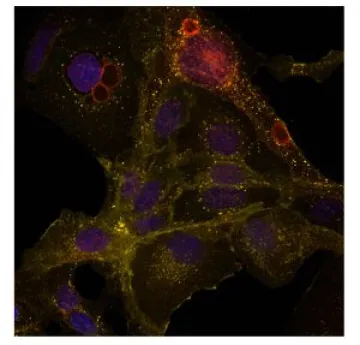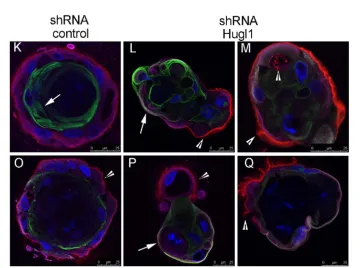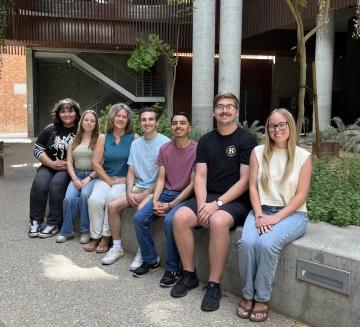Schroeder Lab
The University of Arizona

Figure 1. Upon ligand stimulation in triple negative breast cancer cells, EGFR remains in EEA1-labeled endosomes (yellow puncta) for hours instead of trafficking to the lysosome. Maisel et al., 2017
Much of our work has focused on novel regulators of EGFR and noncanonical functions performed by EGFR in breast cancer. One key event that occurs in cancer is the altered trafficking of ligand-bound receptor. In breast cancer, EGFR can undergo retrograde trafficking, where it resides on long-lived endosomes (Figure 1) or in the nucleus where it can regulate gene transcription directly.
This altered trafficking can be driven by a number of events, including a loss of cellular polarity, interaction with apical proteins or direct mutation of the basolateral targeting domain. Loss of epithelial polarity through the loss of LGL results in a loss of junctional complexes as well as mobilization of the transcription factor TAZ, resulting in a cancer stem cell phenotype and increased migration (Figure 2). These events are dependent upon EGFR, but specifically the noncanonical functions of retrograde trafficked EGFR.

Figure 2. When the polarity protein Hugl1 (LGL) is loss in normal breast epithelium, membrane domains are lost, resulting in the mixing of apical and basal membrane proteins [arrows indicate areas where apical (green) and basal (red/purple) membrane proteins have colocalized (white)]. Russ et al, PLoS One, 2012.
Retrograde trafficking of RTKs appears to be relegated to pathogenic states, including cancer. We have therefore targeted non-canonical EGFR function as well as its retrograde trafficking as a means to develop novel therapeutics. Our first therapeutic target, the interaction between EGFR and the apical protein MUC1, resulted in the peptide based therapeutic, PMIP. While a functional tool for in vivo targeting of MUC1/EGFR interactions, this peptide lacks the stability required for a clinically effective drug. We next focused on the juxtamembrane domain of EGFR, which drives its dimerization, nuclear translocation, calcium signaling and basolateral membrane targeting. This peptide based therapeutic, SAH-EJ1, is highly effective in the inhibition of inflammatory triple negative breast cancer, although it also carries significant toxicities.
Current studies in the lab focus on the role of Sorting Nexins in driving the retrograde trafficking of Receptor Tyrosine Kinases, including EGFR, ERBB3, ERBB4 and the c-Met Receptor. While working to better understand the process of retrograde trafficking, we are also developing therapeutic interventions. In addition, we are currently working to better understand the role of noncanonical EGFR function in driving cancer associated inflammation.

